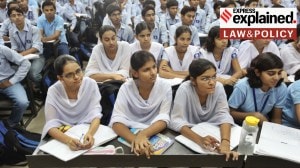Priya Kumari Shukla is a Senior Copy Editor in the Indian Express (digital). She contributes to the UPSC Section of Indian Express (digital) and started niche initiatives such as UPSC Key, UPSC Ethics Simplified, and The 360° UPSC Debate. The UPSC Key aims to assist students and aspirants in their preparation for the Civil Services and other competitive examinations. It provides valuable guidance on effective strategies for reading and comprehending newspaper content. The 360° UPSC Debate tackles a topic from all perspectives after sorting through various publications. The chosen framework for the discussion is structured in a manner that encompasses both the arguments in favour and against the topic, ensuring comprehensive coverage of many perspectives. Prior to her involvement with the Indian Express, she had affiliations with a non-governmental organisation (NGO) as well as several coaching and edutech enterprises. In her prior professional experience, she was responsible for creating and refining material in various domains, including article composition and voiceover video production. She has written in-house books on many subjects, including modern India, ancient Indian history, internal security, international relations, and the Indian economy. She has more than eight years of expertise in the field of content writing. Priya holds a Master's degree in Electronic Science from the University of Pune as well as an Executive Programme in Public Policy and Management (EPPPM) from the esteemed Indian Institute of Management Calcutta, widely recognised as one of the most prestigious business schools in India. She is also an alumni of Jamia Milia Islamia University Residential Coaching Academy (RCA). Priya has made diligent efforts to engage in research endeavours, acquiring the necessary skills to effectively examine and synthesise facts and empirical evidence prior to presenting their perspective. Priya demonstrates a strong passion for reading, particularly in the genres of classical Hindi, English, Maithili, and Marathi novels and novellas. Additionally, she possessed the distinction of being a cricket player at the national level. Qualification, Degrees / other achievements: Master's degree in Electronic Science from University of Pune and Executive Programme in Public Policy and Management (EPPPM) from Indian Institute of Management Calcutta ... Read More
UPSC Key—17 October, 2023: Periodic Labour Force Survey, Sir Syed Ahmad Khan, Surrogacy Laws in India
Exclusive for Subscribers from Monday to Friday: Have you ever thought why Directorate of Enforcement and criticisms of the Surrogacy law in India are relevant to the UPSC Exam? What significance do topics like India’s Manned Mission to Space, Currency depreciation, Sir Syed Ahmad Khan and Women’s Empowerment have for both the preliminary and main exams? You can learn more by reading the Indian Express UPSC Key for October 17, 2023.
 UPSC Key October 2023: Here's what you should be reading from the October 17, 2023 edition of The Indian Express
UPSC Key October 2023: Here's what you should be reading from the October 17, 2023 edition of The Indian Express Important topics and their relevance in UPSC CSE exam for October, 17, 2023. If you missed the October, 16, 2023 UPSC CSE exam key from the Indian Express, read it here
FRONT PAGE
May make AAP accused in excise policy case: ED
Syllabus:
Preliminary Examination: Economic and Social Development
Mains Examination: General Studies III: Money-laundering and its prevention.
Key Points to Ponder:
• What’s the ongoing story- THE ENFORCEMENT Directorate (ED) told the Supreme Court on Monday that it is “contemplating” adding the Aam Aadmi Party (AAP) as an accused in its money laundering probe linked to the Delhi government’s now-scrapped excise policy.
• “The Enforcement Directorate’s (ED) proposal in the Supreme Court to name the Aam Aadmi Party (AAP) as an accused in the Delhi excise policy case will place the Election Commission (EC) in uncharted territory”-Why?
• What is the law under which a political party can be booked for money laundering?
• Do You Know-Section 70 of the stringent Prevention of Money Laundering Act deals with offences by companies. The provision states that, “Where a person committing a contravention of any of the provisions of this Act or of any rule, direction or order made thereunder is a company, every person who, at the time the contravention was committed, was in charge of and was responsible to the company, for the conduct of the business of the company as well as the company, shall be deemed to be guilty of the contravention and shall be liable to be proceeded against and punished accordingly.”
While a political party is not a ‘company’ incorporated under the Companies Act, 2013, the provision has a crucial explanation that could bring a political party under the ambit of the anti-money laundering law.
It reads: “Explanation 1[1].–For the purposes of this section (Section 70),–(i) “company” means any body corporate and includes a firm or other association of individuals;”
The phrase ‘association of individuals’ can include a political party. A party, according to Section 29A of the Representation of the People Act, is any association or body of individual citizens of India calling itself a political party.
• Has a political party ever been booked for money laundering?
• How are the charges against Sisodia tied to AAP?
• What prompted the ED to consider booking AAP as an accused?
• What are the allegations in the “Delhi excise policy scam”?
• How did the ED come into the picture?
• For Your Information- The allegations arose out of a report submitted by Delhi Chief Secretary Naresh Kumar to Lieutenant Governor (LG) Vinai Kumar Saxena in July 2022, pointing to alleged procedural lapses in the formulation of the policy.
The report said “arbitrary and unilateral decisions” taken by Sisodia in his capacity as Excise Minister had resulted in “financial losses to the exchequer” estimated at more than Rs 580 crore. It alleged that “kickbacks…received by the AAP Delhi government and AAP leaders” from owners and operators of alcohol businesses for preferential treatment such as discounts and extensions in licence fee, waiver on penalties and relief due to disruptions caused by the Covid-19 pandemic, etc. were used to “influence” the Assembly elections held in Punjab and Goa in early 2022.
The report was referred to the CBI and led to Sisodia’s arrest.
After the CBI named Sisodia and 14 other accused in its FIR, including AAP communications in-charge Vijay Nair, the ED told a court in March that the alleged proceeds of crime amounted to more than Rs 292 crore, and that it was necessary to establish the modus operandi.
The ED alleged that the “scam” was to give the wholesale liquor business to private entities and fix a 12% margin, for a 6% kickback. In its first prosecution complaint in November 2021, the ED said the policy was “formulated with deliberate loopholes” that “promoted cartel formations through the back door” to benefit AAP leaders.
The ED also alleged that AAP leaders, with Nair as a middleman, received kickbacks to the tune of Rs 100 crore from a group of individuals identified as the “South Group”, who secured uninhibited access to various wholesale businesses and retail zones in violation of rules.
• How was Delhi’s new excise policy different from the existing policy?
• What went wrong with Delhi’s new excise policy?
• What have the ED chargesheets said so far?
• What is Money Laundering?
• How Money Laundering works? What do you understand by placement, layering and integration?
• Money Laundering and its impact?
• Steps Taken by Government of India to Prevent Money Laundering
• Prevention of Money-Laundering Act, 2002 (PMLA)-Key Points
• Prevention of Money-Laundering (Amendment) Act, 2012-Key Highlights
• Directorate of Enforcement (ED)-Role and Function
• ED comes under which Ministry or Organisation?
Other Important Articles Covering the same topic:
📍Can AAP be an accused in excise policy case? Here’s the law
THE CITY
Why is marital status a criteria for woman to avail surrogacy under law: HC to Centre
Syllabus:
Preliminary Examination: Indian Polity and Governance-Constitution, Political System, Panchayati Raj, Public Policy, Rights Issues, etc.
Mains Examination:
• General Studies I: Social empowerment
• General Studies II: Issues relating to development and management of Social Sector/Services relating to Health, Education, Human Resources.
• General Studies II: Structure, organization and functioning of the Executive and the Judiciary-Ministries and Departments of the Government; pressure groups and formal/informal associations and their role in the Polity.
Key Points to Ponder:
• What’s the ongoing story-The Delhi High Court Monday asked the Centre why marital status is a criteria for a woman to avail surrogacy under the law.
A division bench of Chief Justice Satish Chandra Sharma and Justice Sanjeev Narula asked the Centre’s counsel why the marital status of a woman is associated with her eligibility to undergo the procedure.
The Centre’s counsel said that she would seek instructions on this point. The matter is next listed on October 31.
The court was hearing a plea by a 44-year-old single, unmarried woman challenging section 2(1)(s) of the Surrogacy Act, which excludes women like her from availing the procedure while only allowing an Indian widow or female divorcee to take the benefit of the same.
• What is the Surrogacy Act of 2021?
• What are the provisions of the ART Act & Surrogacy Act?
• How surrogacy is defined in Indian Law?
• Do You Know-Under Section 2(1)(s) of the Surrogacy (Regulation) Act 2021, an “intending woman” means an Indian woman who is a “widow” or “divorcee” between the age of 35 and 45 years and who intends to avail the surrogacy.
• What are the conditions for allowing surrogacy, as per the law?
• For Your Information-In India, for a long time, foreign couples opted for surrogacy due to its good and affordable medical system. Over the years, the government has put restrictions on the practice with the stated aim of regulation.
Surrogacy is defined by law as “a practice whereby one woman bears and gives birth to a child for an intending couple” and intends to hand over the child to them after the birth, as per The Surrogacy (Regulation) Act, 2021 (SRA).
It further allows for surrogacy to be available only to infertile Indian married couples. The other legislation on this matter, the Assisted Reproductive Technology (ART) (Regulation) Act, 2021, defines ART procedures as all techniques that attempt to obtain a pregnancy by handling the sperm or the oocyte (the immature female egg) outside the human body and transferring into the reproductive system of a woman. This is open to married couples, live-in partners, single women, and also foreigners. ART procedures include gamete donation, intrauterine insemination, and in-vitro fertilisation or IVF.
The SRA Act says the surrogate should be married and have a child of her own. Restricting altruistic surrogacy to legally wedded infertile Indian couples, the Act sets an age limitation for the couple where a husband must be between 26 and 55 years of age and a wife between 23 and 50 years. Further, Indian couples with biological or adopted children are prohibited to undertake surrogacy, save for some exceptions such as mentally or physically challenged children, or those sufferings from a life-threatening disorder or fatal illness.
Even within this category of people, commercial surrogacy is banned in India and that includes the “commercialisation of surrogacy services or procedures or its component services or component procedures”. The surrogate woman cannot be given payments, rewards, benefits or fees, “except the medical expenses and such other prescribed expenses incurred on the surrogate mother and the insurance coverage for the surrogate mother”.
• Commercial surrogacy and altruistic surrogacy-Compare and contrast
• Who can avail of surrogacy?
• What are some criticisms of the Surrogacy law in India?
Other Important Articles Covering the same topic:
📍Explained: Fine-tuning the Surrogacy Bill
GOVT & POLITICS
Gaganyaan mission: First test vehicle flight on Oct 21
Syllabus:
Preliminary Examination: Current events of national and international importance.
Mains Examination: General Studies III: Awareness in the fields of IT, Space, Computers, robotics, nano-technology, bio-technology and issues relating to intellectual property rights.
Key Points to Ponder:
• What’s the ongoing story-Gaganyaan’s first test vehicle mission that will see the crew module being carried to a height of 17 km to test mid-flight crew escape system will take place on October 21 between 7 am and 9 am, according to Indian Space Research Organisation. Recovery of crew module after splashdown in Bay of Bengal will also be practised during this mission.
• Gaganyaan Mission-Know the key features
• Gaganyaan Mission-What makes this Mission very Unique?
• India’s Manned Mission to Space-Know in detail
• Indian Space Research Organisation (ISRO)-About the Organisation
• The Indian Human Spaceflight Programme (IHSP) and Gaganyaan – About and Key Features
• Indian Space Research Organisation (ISRO)-Background, Achievements and upcoming Missions
• Do You Know-A manned space mission is very different from all other missions that ISRO has so far completed. In terms of complexity and ambition, even the missions to the Moon (Chandrayaan) and Mars (Mangalyaan) are nowhere in comparison. For a manned mission, the key distinguishing capabilities that ISRO has had to develop include the ability to bring the spacecraft back to Earth after flight, and to build a spacecraft in which astronauts can live in Earth-like conditions in space. Over the years, ISRO has successfully tested many of the technologies that are required, but many others are still to be developed and tested.
The Environmental Control & Life Support System (ECLSS) is meant to ensure that conditions inside the crew module are suitable for humans to live comfortably. The inside of the crew module is a twin-walled sealed structure that will recreate Earth-like conditions for the astronauts. It would be designed to carry two or three astronauts. The ECLSS maintains a steady cabin pressure and air composition, removes carbon dioxide and other harmful gases, controls temperature and humidity, and manages parameters like fire detection and suppression, food and water management, and emergency support.
While the layout and design of the ECLSS has been finalised, its many individual components and systems are in the process of being tested. The design and configuration of the inside of the crew module have also been finalised. Ground testing will have to be followed by tests in the space orbit while simulating zero gravity and deep vacuum.
• The human spaceflight mission had initially been given a 2022 target by the Centre to coincide with 75 years of Indian independence but the programme got delayed-why?
Other Important Articles Covering the same topic:
📍Gaganyan: How to send an Indian into space
SC refers petitions against electoral bonds scheme to five-judge bench
Syllabus:
Preliminary Examination: Indian Polity and Governance
Main Examination: General Studies II: Important aspects of governance, transparency and accountability
Key Points to Ponder:
• What’s the ongoing story-The Supreme Court on Monday referred petitions challenging the 2018 Electoral Bonds Scheme to a five-judge Constitution Bench. While presiding over a three-judge bench, Chief Justice of India D Y Chandrachud made the announcement during mentioning hours, when matters that require urgent attention are brought to the notice of the court.
The CJI said, “In view of the importance of the issue raised, and with regard to Article 145(4) of the Constitution of India, the matter be placed before a bench of at least five judges”.
Though the petitioners had raised the demand to refer it to a Constitution Bench even earlier, the SC had not shown inclination to do the same. Taking it up on October 10, the CJI-led bench had fixed October 31 to hear it.
• What are the petitions contesting the validity of the 2018 Electoral Bonds Scheme?
• What is Article 145(4) of the Constitution of India?
• For Your Information-The top court is seized of a clutch of petitions including by two NGOs Common Cause and Association for Democratic Reforms (ADR), Congress leader Jaya Thakur and the CPI(M) challenging the scheme.
While the Centre has termed the scheme “a big step towards electoral reform” which “will ensure transparency” and “accountability”, petitioners have contended that it affects transparency in political funding. The petitioners have pointed out that it allows political parties not to disclose their annual contribution reports to the Election Commission of India (ECI) and details of the identity of those who have donated through the Electoral Bonds.
In April 2019, a three-judge SC bench, in an interim order, directed political parties, which received donations through Electoral Bonds, to “forthwith” submit the details of the bonds to the ECI.
Subsequently, while dismissing a prayer to stay the sale of fresh bonds in March 2021, the SC disputed the petitioner’s contention regarding the “complete anonymity” of bond purchasers. The Supreme Court had said, “It is not as though the operations under the scheme are behind iron curtains incapable of being pierced”.
The top court pointed out that bonds had been issued in the past — in 2018, 2019 and 2020 — “without any impediment” and it had already ordered “certain safeguards” by way of its April 2019 interim order.
The Supreme Court also referred to the EC receiving details of contributions received through bonds, in pursuance of the April 2019 order.
• What is the electoral bonds scheme?
• Electoral Bonds-Key Features
• What was the rationale behind the electoral bonds scheme?
• Why is the scheme facing a legal challenge and what are its larger criticisms?
• For Your Information-Announced in the 2017 Union Budget, electoral bonds are interest-free bearer instruments used to donate money anonymously to political parties. Simply put, anyone can donate money to political parties through them.
Such bonds, which are sold in multiples of Rs 1,000, Rs 10,000, Rs 1 lakh, Rs 10 lakh, and Rs 1 crore, can be bought from authorised branches of the State Bank of India (SBI). As such, a donor is required to pay the amount — say Rs 10 lakh — via a cheque or a digital mechanism (cash is not allowed) to the authorised SBI branch.
The political parties can choose to encash such bonds within 15 days of receiving them and fund their electoral expenses. There is no limit on the number of bonds an individual or company can purchase. If a party hasn’t enchased any bonds within 15 days, SBI deposits these into the Prime Minister’s Relief Fund.
When first announced in then Finance Minister Arun Jaitley’s Budget speech of 2017, he had said, “Even 70 years after Independence, the country has not been able to evolve a transparent method of funding political parties which is vital to the system of free and fair elections…Political parties continue to receive most of their funds through anonymous donations which are shown in cash. An effort, therefore, requires to be made to cleanse the system of political funding in India.”
Two main changes were proposed then. One, it reduced the amount of money that a political party could accept in cash from anonymous sources — from Rs 20,000 to Rs 2,000. Two, he announced the introduction of electoral bonds as a way to make such funding more transparent.
However, the fine print of the notification has revealed that even individuals, groups of individuals, NGOs, religious and other trusts are permitted to donate via electoral bonds without disclosing their details.
• Which Bank is the only bank authorised to sell Electoral Bonds?
• Electoral Bonds and associated issues
• When are the bonds available for purchase?
• Are electoral bonds taxable?
• Why were electoral bonds introduced in India?
• Why are electoral bonds being so vehemently opposed by transparency activists?
• How popular are electoral bonds as a route of donation?
• What does the Supreme Court have to say on electoral bonds?
• What is the Election Commission’s stand on electoral bonds?
• Reserve Bank of India on electoral bonds scheme?
Other Important Articles Covering the same topic:
📍Explained: Why the electoral bonds scheme has been challenged in Supreme Court
THE EDITORIAL PAGE
Syllabus:
Preliminary Examination: History of India and Indian National Movement.
Mains Examination: General Studies II: Modern Indian history from about the middle of the eighteenth century until the present significant events, personalities, issues.
Key Points to Ponder:
• What’s the ongoing story- Shafey Kidwai Writes: Sir Syed Ahmed Khan is rightly lauded for propagating modern education among Muslims and advocating several reforms for the community. But he is also faulted for siding with the country’s colonial rulers and doing little for women’s education. Sir Syed’s 125th birth anniversary coincides with the passing of the Women’s Reservation Bill. It is time to analyse if the great reformer stood for women’s social, educational, cultural and religious emancipation. One has to revisit his writings and actions that prompted historian David Lelyveld to describe Sir Syed as “hardly a man of modern ideas that we usually take him for”.
• Sir Syed Ahmad Khan-Know about him
• In what ways Sir Syed Ahmad Khan improved the educational and social systems of the country?
• Sir Syed Ahmad Khan and Aligarh Movement-Connect the dots
• Sir Syed Ahmad Khan and Women’s Empowerment-Know in detail
• “Sir Syed’s 125th birth anniversary coincides with the passing of the Women’s Reservation Bill. It is time to analyse if the great reformer stood for women’s social, educational, cultural and religious emancipation”-Comment
• Why Sir Syed Ahmad Khan has he been controversial figure in Indian history?
• What was Sir Syed’s concept of nation?
• What is the two nation theory of Sir Syed Ahmed Khan?
• “When a nation becomes devoid of arts and learning, it invites poverty.” In the light of this statement, assess the role of Sir Syed Ahmad Khan as a in as a reformer in modern India.
• What were the views of Sir Syed Ahmed Khan on modernization?
Other Important Articles Covering the same topic:
📍Indian Muslims must re-read Syed Ahmad Khan
📍Making sense of Sir Syed’s legacy today
ECONOMY
Rupee at all-time low against dollar as oil, other currencies rise
Syllabus:
Preliminary Examination: Current events of national and international importance.
Mains Examination: General Studies III: Indian Economy and issues relating to planning, mobilization, of resources, growth, development and employment.
Key Points to Ponder:
• What’s the ongoing story- The Indian rupee on Monday ended at its lifetime closing low of 83.28 against the dollar as a jump in crude oil prices and weakness in other Asian currencies pressured the currency. The rupee closed at 83.2775/28 against the US dollar as against its previous close of 83.26. The currency hit its previous record closing low of 83.2675 on September 18.
• Why is Indian rupee getting weaker?
• What determines the rupee’s demand and supply vis-a-vis other currencies?
• What is Currency depreciation?
• What do you understand by Rupee depreciation?
• Appreciation vs Depreciation of Currency-Compare and Contrast
• What is Devaluation of Currency? Depreciation and Devaluation both are same?
• What are the reasons for Current Depreciation of Indian Rupee?
• How does the rupee’s exchange rate fluctuate?
• What is the RBI’s role in this?
• Is a fall in the exchange rate necessarily a bad thing?
Other Important Articles Covering the same topic:
📍Making sense of exchange rate
📍Why the Indian rupee fell 10% against the US dollar in 2022
Angel tax: How does CBDT’s new clarification affect start-up companies?
Syllabus:
Preliminary Examination: Economic and Social Development-Sustainable Development, Poverty, Inclusion, Demographics, Social Sector Initiatives, etc.
Main Examination: General Studies III: Indian Economy and issues relating to planning, mobilization, of resources, growth, development and employment.
Key Points to Ponder:
• What’s the ongoing story- Amid notices being sent to start-ups, the Central Board of Direct Taxes (CBDT) has stepped in to direct its officers to not carry out scrutiny of angel tax provisions for start-ups recognised by the Department for Promotion of Industry and Internal Trade (DPIIT).
In a directive issued last week, the tax department has asked its field officials to not do verification for the recognised start-ups for cases pertaining to Section 56 (2) (viib) of the Income-tax Act, which was amended in the Finance Act, 2023 bringing in non-resident investors also under the angel tax levy.
• What is the meaning of angel tax?
• Does India have angel tax?
• Do You Know- Angel tax – which is income tax at the rate of 30.6 per cent – is levied when an unlisted company issues shares to an investor at a price higher than its fair market value. Earlier, it was imposed only on investments made by a resident investor. However the Finance Act 2023 proposed to extend angel tax even to non-resident investors from April 1. The Finance Act, 2023, had amended Section 56(2)(viib) of the Income-tax Act. The provision, colloquially known as the ‘angel tax’ was first introduced in 2012 to deter the generation and use of unaccounted money through the subscription of shares of a closely held company at a value that is higher than the fair market value of the firm’s shares. The provision stated that when an unlisted company, such as a start-up, receives equity investment from a resident for issue of shares that exceeds the face value of such shares, it will be counted as income for the start-up and be subject to income tax under the head ‘Income from other Sources’ for the relevant financial year. With the latest amendment, the government had proposed to also include foreign investors in the ambit, meaning that when a start-up raises funding from a foreign investor, that too will now be counted as income and be taxable. The DPIIT-recognised startups were excluded from the angel tax levy.
• What are the concerns regarding the exemptions? What do experts say on this?
• What is the new tax directive on start-ups?
• What is angel tax for start-ups ?
• What were the changes for angel tax in Budget 2023-24?
Other Important Articles Covering the same topic:
📍Why a proposed change in Angel Tax has rattled Indian start-ups
EXPLAINED
Syllabus:
Preliminary Examination: Economic and Social Development-Sustainable Development, Poverty, Inclusion, Demographics, Social Sector Initiatives, etc.
Mains Examination:
• General Studies I: Social empowerment
• General Studies II: Welfare schemes for vulnerable sections of the population by the Centre and States and the performance of these schemes; mechanisms, laws, institutions and Bodies constituted for the protection and betterment of these vulnerable sections.
• General Studies II: Issues relating to development and management of Social Sector/Services relating to Health, Education, Human Resources.
• General Studies‐ III: Indian Economy and issues relating to planning, mobilization, of resources, growth, development and employment
• General Studies III: Inclusive growth and issues arising from it
Key Points to Ponder:
• What’s the ongoing story- Last week, the Ministry of Statistics and Programme Implementation released the results of the Periodic Labour Force Survey for the period July 2022 to June 2023. This is the sixth PLFS report and each tracks a 12 month period between July and June.
• What is Periodic Labour Force Survey (PLFS)?
• Who publishes Periodic Labour Force Survey (PLFS)?
• What is the Significance of PLFS reports?
• What are the key employment and unemployment indicators used in Periodic Labour Force Survey (PLFS)?
• Do You Know-The annual PLFS — as well as its predecessor, the quinquennial Employment-Unemployment Surveys — are conducted by the National Sample Survey Office in order to get an understanding about the state of employment in India.
The PLFS provides data on different metrics so that the policymakers can understand the proportion of people demanding work, the proportion of people among them who failed to get a job, the gender differences in employment as well as wages etc. The PLFS also tells the sectoral distribution of workers in the economy — what percentage is involved in agriculture, for instance. It also records the type of work people do — for instance, how many are engaged in casual labour, how many work for themselves, and how many have regular salaried jobs etc.
It is also noteworthy that PLFS collects data in two ways — Usual Status (US) and Current Weekly Status (CWS). Broadly speaking, within usual status, the survey respondent has to recall their employment details from the last one year while in the CWS, the respondent has to recall the details over the past one week.
More precisely, the estimate of the labour force in the usual status includes
1. the persons who either worked or were seeking/available for work for a relatively long part of the 365 days preceding the date of survey and also
2. those persons from among the remaining population who had worked at least for 30 days during the reference period of 365 days preceding the date of survey
The estimate of the labour force according to the current weekly status approach is derived by considering those who worked for at least 1 hour or was seeking/ available for work for at least 1 hour on any day during the 7 days preceding the date of survey.
Increasingly, the global practice has been to focus more on CWS because the recall is better over the past week.
Most of the findings below are all based on CWS.
• What latest findings says in general??
• What latest findings says about Unemployment Rate in particular?
• Employment Rate (ER) and Unemployment Rate (UER)-Know in Detail
• What Is the Unemployment Rate? How it is Calculated by CMIE?
• Centre for Monitoring Indian Economy (CMIE)-Role and Under which Ministry/Organisation?
• Reasons for rise in Unemployment Rate?
• What latest findings says about Labour Force Participation Rate?
• What do you understand by Labour Force and Labour Force participation rate (LFPR)?
• What latest findings says about Female Labour Force Participation Rate?
Other Important Articles Covering the same topic:
📍Telangana youth joblessness highest; Rajasthan, Mizoram over national avg
📍Unemployment rate drops to 6.6% in urban areas in Q1
For any queries and feedback, contact priya.shukla@indianexpress.com
The Indian Express UPSC Hub is now on Telegram. Click here to join our channel and stay updated with the latest Updates.
Photos





- 01
- 02
- 03
- 04
- 05



























